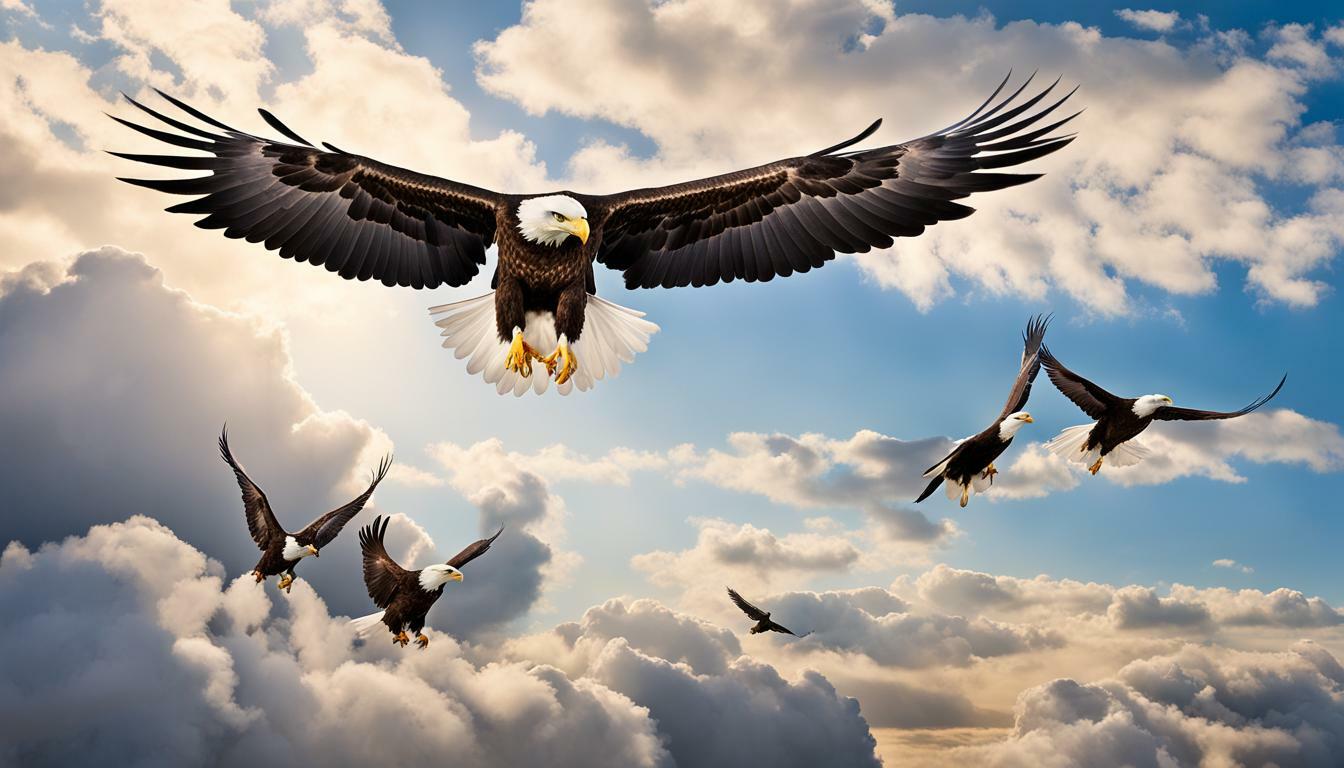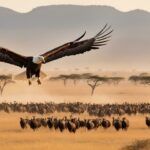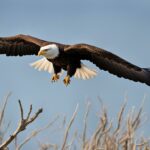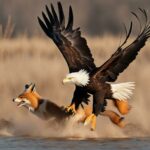Have you ever wondered if eagles fly together? These majestic birds have captured the imagination of humans for centuries, inspiring art, literature, and even national symbols. In this article, we’ll explore the behavior of eagles and the symbolism associated with them to answer the age-old question: do eagles fly together?
Eagles are known for their impressive wingspans, sharp talons, and keen eyesight. They’re also known for their solitary nature, often hunting and nesting alone. However, there are certain behaviors that suggest eagles do fly together at times, and their symbolism reinforces this idea.
Key Takeaways:
- Eagles are known for their solo nature but exhibit certain behaviors that suggest they do fly together.
- The symbolism associated with eagles reinforces the idea of them flying together in a metaphorical sense.
- Understanding eagle behavior and broader concepts of unity in nature can shed light on the fascinating connection between eagles and the idea of flying together.
Understanding Eagle Behavior
Have you ever wondered whether eagles fly together? To answer this question, we must first examine eagle behavior and how it relates to other avian behavior.
Eagles are known for their impressive flight patterns, soaring through the sky with a grace and power unmatched by many other birds. They are also solitary creatures, preferring to hunt and travel alone rather than in flocks. However, this does not mean that eagles do not exhibit any socialization or teamwork within their species.
Studies have shown that eagles do, in fact, exhibit some flocking tendencies and socialization with others of their kind. For example, during the breeding season, eagles may congregate in areas with abundant food and suitable nesting sites. Within these areas, they may interact with other eagles, engaging in courtship displays and defending their territories.
While eagles may not fly in flocks like some other bird species, they do exhibit certain behaviors that suggest a level of teamwork and unity. For example, when hunting, eagles may work together to distract and confuse their prey, allowing one bird to swoop in for the kill. This demonstrates a form of cooperation and strategy that is essential for survival.
By understanding eagle behavior and their tendency towards teamwork, we can begin to draw conclusions about whether eagles truly fly together. While they may not always be seen flying in large flocks, their behavior suggests that they do work together and exhibit a form of unity within their species, just in a different way than some other birds.
The Symbolism of Eagles
Eagles have long been associated with symbolism and mythology due to their impressive size and majestic flight patterns. These birds have been revered in cultures across the world, from ancient Greece to Native American traditions.
One of the most common symbols associated with eagles is freedom. Their ability to soar high above the earth without constraints has led them to become a symbol of liberty and independence. Additionally, eagles are often associated with strength and power, as they are formidable predators and incredibly resilient creatures.
When considering the concept of whether eagles fly together, their symbolism can provide some insight. While eagles may not always fly in flocks like some other bird species, their tendency to exhibit unity and cooperation with other eagles reinforces the idea of them flying together in a metaphorical sense.
Furthermore, the symbolism of eagles flying together can also be interpreted as a representation of the power of teamwork. Just as eagles work together to catch prey and defend their territory, humans can achieve great things through collaboration and mutual support.
Unity in Nature and Teamwork
Animals in nature exhibit remarkable teamwork and unity, whether it’s a pack of wolves hunting for food or a group of ants carrying a large leaf back to their colony. Team unity is crucial for survival in many species, and eagles are no exception.
While eagles may not typically fly in flocks like some other birds, they do exhibit a sense of teamwork and unity in their behavior. For example, during courtship displays, eagles will often fly together, soaring and performing a variety of acrobatic maneuvers in unison.
In addition, eagles are often seen working together when defending their territory or caring for their young. They will call out to each other, coordinate their movements, and work together to fend off threats or gather food.
The concept of unity in nature extends beyond the animal kingdom, with plants and other organisms also exhibiting remarkable cooperation and interdependence. For example, trees in a forest will often share nutrients and resources through their root systems, allowing weaker trees to survive and thrive.
Understanding the importance of teamwork and unity in nature can help us appreciate the fascinating connection between eagles and the idea of flying together. While they may not always fly in flocks, they do exhibit a sense of unity and cooperation in their behavior, which is crucial for their survival and success.
Examining Eagle Flight Patterns
Understanding the flight patterns of eagles is crucial in determining whether they fly together. Eagles are known for their powerful and graceful flying capabilities, soaring above mountain ranges and coastlines.
Eagles will often fly alone or with their mate during breeding season, but they may also fly in pairs or small groups during migration. When flying together, eagles will typically follow a V-shaped pattern, with one eagle leading and the others following closely behind.
| Eagle Flight Behavior | Description |
|---|---|
| Thermaling | Eagles use thermal currents to gain altitude and conserve energy during flight |
| Soaring | Eagles will soar for extended periods of time using their large wingspan and efficient gliding abilities |
| Hunting | Eagles will fly low and slow when hunting, utilizing their keen eyesight to spot prey from above |
Eagles are also known for their acrobatic flying, performing dives and loops to catch prey or impress their mate during courtship. Their flight patterns are heavily influenced by their environment, including wind currents and topography.
While eagles may not always fly together in large flocks, their flight behavior demonstrates a level of coordination and unity within their species.
The Importance of Team Unity
Team unity is a crucial concept in both nature and human society. In the animal kingdom, many species exhibit teamwork and cooperation in order to increase their chances of survival. For example, a pack of wolves will work together to take down prey, while a herd of zebras will form a protective circle around young members to fend off predators.
Similarly, in human society, teamwork and unity are essential for success in many areas, such as sports, business, and even families. When individuals work together towards a common goal, they can accomplish more than they would on their own.
For eagles, team unity may not always manifest in the form of flying together in flocks. However, they do exhibit behaviors that demonstrate a sense of unity and cooperation. For example, during the breeding season, male and female eagles work together to build and maintain their nest, as well as care for their young.
Additionally, eagles have a strong sense of territoriality and will defend their nest and surrounding area from intruders. This protective behavior shows a sense of unity and cooperation between eagles within a territory.
Overall, while eagles may not always fly together in flocks, their behavior demonstrates the importance of team unity and cooperation in nature. By understanding this concept, we can appreciate the fascinating connection between eagles and the idea of flying together in a broader sense.
Conclusion
After exploring the behavior of eagles and the symbolism associated with them, we can conclude that while eagles may not always fly together in flocks like some other birds, they do display certain behaviors and tendencies that demonstrate unity and teamwork.
Understanding their flight patterns and socialization within their species sheds light on their tendency to work together. Furthermore, the symbolism associated with eagles, such as freedom, strength, and power, reinforces the idea of them flying together in a metaphorical sense.
By examining broader concepts of unity in nature and the importance of team cohesion, we can appreciate the fascinating connection between eagles and the idea of flying together. While eagles may not fly in perfect formation, they work together for the greater good, just as teams do in both nature and human contexts.
Do Birds Have a Sense of Direction and Memory?
Birds remembering feeder locations is a testament to their remarkable sense of direction and memory. These intelligent creatures navigate vast distances during migration, relying on internal compasses and landmarks. Their ability to recall specific feeding spots is an impressive display of their cognitive abilities. Whether it’s due to spatial memory or other cognitive processes, birds’ capacity to remember and find feeder locations continues to fascinate researchers worldwide.
FAQ
Q: Do eagles always fly together?
A: While eagles do not always fly together in flocks like some other bird species, they do exhibit certain behaviors that demonstrate unity and teamwork.
Q: What are some examples of eagle behavior?
A: Eagles have distinct flight patterns, flocking tendencies, and engage in socialization within their species.
Q: What is the symbolism associated with eagles?
A: Eagles are often symbolized as representations of freedom, strength, and power.
Q: How does unity in nature relate to eagles?
A: Exploring unity in nature, including examples of teamwork and cooperation among animals, can help us draw parallels to the concept of eagles flying together.
Q: What are some factors that influence eagle flight patterns?
A: Eagle flight patterns can be influenced by factors such as navigation of surroundings and potential reasons for their flight behavior.
Q: Why is team unity important?
A: Understanding the significance of team unity, both in nature and in human contexts, can provide insights into eagles and their flying habits.
Q: What can we conclude about eagles and flying together?
A: While eagles may not always fly together in flocks, their behaviors and symbolism suggest a connection to unity and teamwork. By understanding their behavior and exploring broader concepts of unity in nature, we can appreciate the fascinating relationship between eagles and the idea of flying together.











